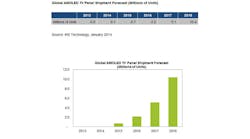After having a major presence at this year’s CES, active-matrix-organic-light-emitting-diode (AMOLED) television sets are expected to see rising shipments. Although the sets remain expensive, compelling products and resolved manufacturing challenges are expected to bring sales to 10 million by 2018, according to a report from IHS Technology.
AMOLED displays are capable of providing higher refresh rates than their previous-generation counterparts, which improves response time while decreasing power consumption. Panels for the sets are projected to amount to 50,000 in 2014, with only LG Displays expected to ship a large volume. Shipments will rise to 700,000 in 2015 and then increase to 2.2 million in 2016 and 5.1 million in 2017. LG, Samsung, and Panasonic all showed a variety of AMOLED TVs at CES 2014. They included a range of screen sizes, ultra-high-definition (UHD) resolution, and even curved displays.
LG’s dominance in the market has been attributed to a high-end distribution channel and local very, very important people (VVIP) marketing activity. The company’s market is split into two segments: a high-end portion with curved and UHD OLED panels and a mass market with flat and full-HD AMOLED panels. At CES, LG showcased a 77-in. bendable UHD AMOLED TV that used a white-OLED (WOLED) display based on oxide thin-film-transistor (TFT) technology. LG currently runs 8000 sheets per month of its eight-generation WOLED fab, but expects to expand production to 26,000.
Samsung showed a 55-in. curved full-HD OLED TV that uses an RGB separated AMOLED panel based on low-temperature-polysilicon (LTPS) TFT technology. The company currently runs 10,000 sheets per month at an eight-generation fab. Panasonic announced five versions of a 55-in. curved UHD OLED TV--each with different bending points and radiuses. Panasonic’s panels are developed with oxide TFT in conjunction with Sony and AU Optronics.
The showings at CES indicate that television brands remain committed to promoting AMOLED technology. Shipments will increase as production issues decrease and prices respond by dropping. Markets outside the U.S. are catching on as well. Chinese TV makers like TCL, Hisense, and Changhong have announced AMOLED sets that are expected to start shipping soon.
